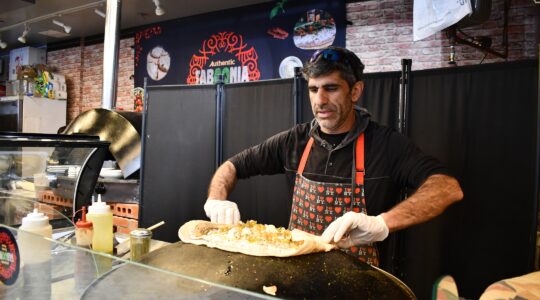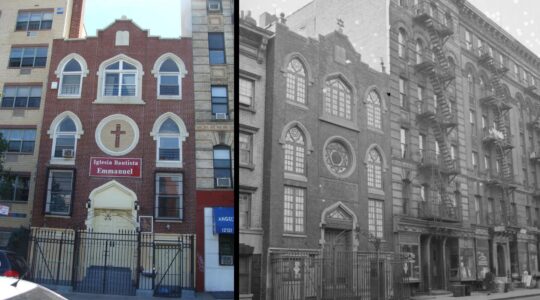Just over a year ago, the Metropolitan Museum of Art purchased one of the most important Jewish manuscripts to survive medieval Spain. This 14th-century Spanish Bible from the Castile region is one of only three surviving decorated Hebrew Bibles from the region. Its uniqueness is in the beauty of the manuscript, with its clean margins and uniform penmanship, complex micrographical patterns, illuminated initial panels and intricate designs on its opening carpet pages.
These highly decorative opening pages are a testament to a time in Spain described by scholars as the Convivencia, when Islamic, Christian and Jewish cultures blended and influenced each other to create a common aesthetic while maintaining unique cultural expressions.
But the Spanish Hebrew Bible’s presence at the Met was something of an anomaly. For years the prestigious institution, located in the city with the country’s largest Jewish population, had a visible hole in its robust collection, according to experts — it lacked Jewish ritual art. (The museum’s walls are, of course, filled with Jewish artists from Marc Chagall to Mark Rothko.) In terms of the dearth of ritual art, several factors are seen at play.
Some art world observers have argued that there simply aren’t many beautiful pieces of medieval Jewish art available for acquisition that meet the Met’s standards. While medieval Christian art was preserved in churches and libraries, many Jewish works of art were destroyed by persecution or were lost to the vicissitudes of a diasporic reality. Others have argued that for years, Jewish ritual art was not considered by great institutions to have a place among the great works of art; that Jewish ritual art could neither contribute to our understanding of past cultures or even provide a beautiful aesthetic.
But in recent years, change is afoot and the Met has made a concerted effort to increase its Jewish holdings, recently highlighted with the purchase of the Spanish Hebrew Bible.
Sharon Liberman Mintz, senior consultant in Judaica at Sotheby’s and curator of Jewish Art at the Jewish Theological Seminary, noted that many of the most prestigious art institutions have begun to recognize the importance of having Jewish art in any broad collection. “The Metropolitan has been at the forefront of this quiet shift,” she said. “Through acquisitions and loans, it has shown that Judaica is both significant and integral to having a world-class institution.”
…It has shown that Judaica is both significant and integral to having a world-class institution.
Two curators in the museum’s Medieval Wing are fueling the change:
Barbara Boehm and Melanie Holcomb. Boehm, who is the Paul and Jill Ruddock Senior Curator for The Met Cloisters, explained that “displaying works of Jewish artistic heritage has allowed us to present a more complete view of European culture than traditionally was the case. In art made for the Jewish communities of medieval Europe, we can find objects of soaring beauty, and of profound intellect, sometimes with touches of humor or whimsy, and often with touching histories.”
The visibility of Jewish art increased significantly with the 2011 exhibition, “The Washington Haggadah: Medieval Jewish Art in Context”; since then, the Met has displayed important Jewish medieval illustrated manuscripts, including the Cervera Bible, a designated national treasure from the National Library of Portugal in Lisbon, and the John Rylands Haggadah from the Ryland University Library in Manchester, England.
Liberman Mintz notes that having these Jewish treasures in an institution such as the Metropolitan allows visitors to clearly see how Judaica reflects the broader cultures in which Jews lived. By seeing these pieces of Jewish art surrounded by the material culture of the time, she said, the viewer gains a sense of the world in which these medieval Jews lived.
The museum has made efforts to highlight this context, sometimes subtly and sometimes overtly. First, all the Jewish items are placed alongside contemporary and contextually similar objects. Second, curators have tried to bring artifacts to life by using the museum’s robust collection as accompaniments.
For example, alongside the Washington Haggadah’s illustration of a German Jewish woman roasting her paschal lamb, the exhibit displayed a 15th-century swatch of fabric that closely resembled the patterns and textures of the woman’s dress. Similarly, adjacent to an image of a Jewish man holding a cup to make kiddush, sits an identical looking beaker.
Said Boehm: “It allowed our visitors to imagine a Passover table at which art was front and center, with the illuminated manuscript, the velvets, the wine glasses all integral to the feast, all honoring the holiday.”
The Metropolitan followed these exhibitions with a volley of acquisitions, some of which were the most important and significant items of their kind. In September 2013, it acquired its most important piece of Jewish art, a 15th-century Italian Renaissance illuminated Mishneh Torah manuscript, from the collection of Judy and Michael Steinhardt. This masterpiece is the second half of a two-volume illuminated Mishneh Torah, Maimonides’ monumental work. The one-of-a-kind illustrations that complement the text reveal not only knowledge of the Mishneh Torah’s content, but also a detailed understanding of the actual laws.
In addition, the illustrations, which are attributed to a non-Jewish artist, use scenes from the quotidian Renaissance world. The men and women wear in typical Renaissance garb featuring jerkins, doublets and hose, while the homes and cities feature Italian architecture.
The Met followed this acquisition with the purchase of two sets of Torah ornaments, a large 18th-century Venetian silver Torah Crown and a pair of silver Torah finials (rimonim) from Georgia. (Three years after the acquisition of the Torah crown from Sotheby’s, the museum acquired the corresponding finials to reunite the crown with finials and complete the set.)
More recently, while the Library of the Jewish Theological Seminary facility is under construction, the Met has entered a loan agreement with the library and is currently exhibiting four manuscripts, three at the Met Fifth Avenue and one at the Cloisters; all have unique beauty and fascinating stories.
On display at the Cloisters is the Prato Haggadah, one of the finest Haggadot from 14th-century Spain. While it contains immaculate penmanship and glittering illuminated images, its uniqueness lies in the fact that it is incomplete. While over 30 pages have colored images, most of the images are incomplete. And while art historians speculate as to why it was unfinished, all agree that the incomplete progression of decoration teaches us a lot about the methods and techniques of 14th-century manuscript construction.
Currently on display at the Met Fifth Avenue in the Medieval Wing are three rare manuscripts from the JTS library’s collection: the Siddur Austria, the Farissol Women’s Siddur and the prayer book from the workshop of Mariano del Buono.
The Siddur Austria, or “Tiny Mahzor,” is a “pocket-sized” 13th-century German (Ashkenazi) seasonal prayer book (mahzor) that contains special piyutim (special seasonal prayers) recited on festivals and numerous folk-art style illustrations. One image offers a window into medieval Jewish life, as the viewer looks in through the clover-shaped synagogue window and see a man wearing a “Jew’s” hat standing before a lectern and grasping a Torah scroll. Another illustration offers a glimpse into the intimate domestic life of a husband and wife as they prepare for Shabbat.
Next to the Medieval Wing, the Medieval Treasury houses two lavishly decorated prayer books: the Abraham Farissol Siddur and the prayer book from the workshop of Mariano del Buono, both of which were produced in Renaissance Italy. And while the artistic styles represent their common cultural milieu, an additional element unites these two prayer books: both were written for women. Both present the morning blessings in the feminine gender and the Farissol Siddur includes the blessing “Blessed is He who made me a Woman and not a Man.”
In addition to these prominent manuscripts in the Medieval Wing, throughout the museum more Jewish treasures have been put on display in recent years. The Near Eastern Wing displays two tiles from the Dura Europos Synagogue and a jug that contained some fragments of the Dead Sea Scrolls. The Late Roman and Early Byzantine exhibition hallway showcases a glass fragment with a golden depiction of a Torah Ark, a coin from the Bar Kokhba rebellion, and a glass pilgrimage jar with embossed images of a menorah and shofar. And the New Galleries for the Art of Arab Lands contains a floor tile from the El Transito Synagogue of Toledo and several important Hebrew manuscripts.
Taken together, all of the new Jewish works acquired recently by the Met paint a fuller picture of medieval Jewish life and the ways Jewish art developed in a larger historical and artistic context.
For Holcomb, curator in the Department of Medieval Art at The Cloisters, the new acquisitions amount to “a great start. I would love in time to see great examples of Judaica dispersed throughout the Met’s galleries as a testimony to Jewish artistic presence across cultures and through time.”
Rabbi Yigal Sklarin teaches Talmud and Jewish history at The Ramaz Upper School. He served as an intern at the Metropolitan Museum of Art’s medieval department in the summer of 2014 and since then has been a volunteer researcher.
The New York Jewish Week brings you the stories behind the headlines, keeping you connected to Jewish life in New York. Help sustain the reporting you trust by donating today.




